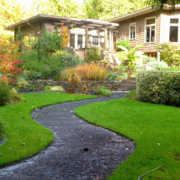Tips for Responsible Lawn Maintenance
While the goal of many sustainable landscaping plans is to remove the traditional suburban lawn, sometimes a portion of lawn area is maintained.
You can ensure that your lawn stays healthy, permeable and green by using sustainable landscaping tips for lawn maintenance:
- Grass cycling
- Using proper mowing height and frequency
- Eliminating chemical use
- Monitoring watering frequency and duration
- Using organic amendments, particularly compost
Turf should be top dressed with one-eighth to one-quarter of compost once or twice yearly. This minimizes the need for resource inputs, the ability of lawn areas to act as infiltration and filter areas, and reduces polluted runoff.
Ideal placement and grass type
Turf should ideally be used where it serves a specific purpose, like a play area. It should be avoided in inaccessible or decorative areas like parkways, median strips, islands, or front yards. Turf should be avoided on all slopes.
Sustainable landscaping for responsible lawn maintenance
Warm season grass is the best choice for most areas in San Diego County. Warm season grass prefers temperatures of 80 degrees or more, and will go dormant in the winter when it is rainy and cool. Typically these grasses grow from sturdy rhizomes that extend deep underground.
Warm season grass also uses less water than cool season grass and is a moderate water use plant. Consider overseeing your grass with clover to make it more interesting and drought-tolerant.
This article was inspired by the 71-page Sustainable Landscapes Program guidebook available at SustainableLandscapesSD.org. The Water Authority and its partners also offer other great resources for landscaping upgrades, including free WaterSmart classes at WaterSmartSD.org.




